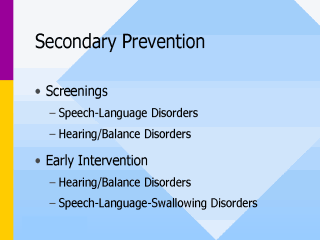| front |1 |2 |3 |4 |5 |6 |7 |8 |9 |10 |11 |12 |13 |14 |15 |16 |17 |18 |19 |20 |review |
 |
Examples of
Secondary Prevention: A. Screenings and follow-up across the lifespan for 1. Auditory/Balance Disorders (universal newborn hearing screening, screening hearing, middle-ear function, and central auditory processing).2. Speech-Language Disorders a. Screening speech, language, voice, and oral mechanism and related behaviors.b . Educating parents about dysfluencies in preschool children, and the value of early intervention.B. Early Preventive Intervention, that is, using treatments targeting toward developmental issues such as early communication development. 1. Auditory/Balance Disorders(audiologic habilitation, amplification and assistive listening devices, vestibular rehabilitation) 2. Speech-Language Disorders (literacy, augmentative/alternative communication devices). Transition: As previously defined, tertiary prevention is an attempt to decrease the severity or impact of a disability associated with an existing disorder or disease…. |